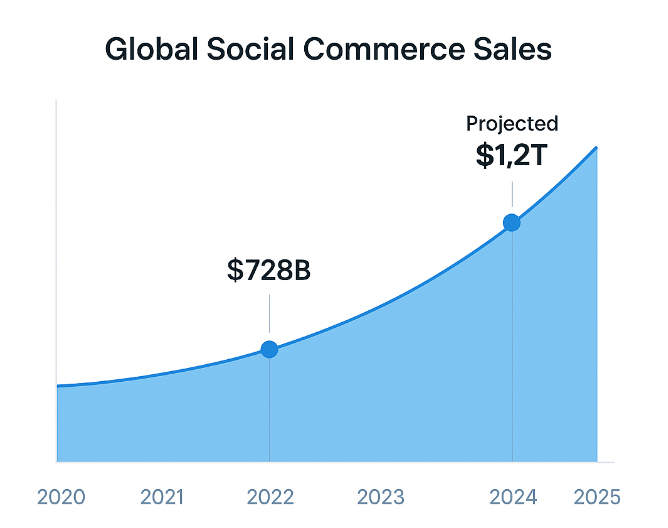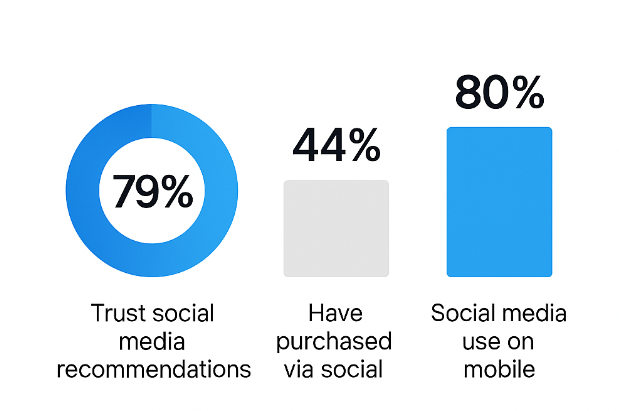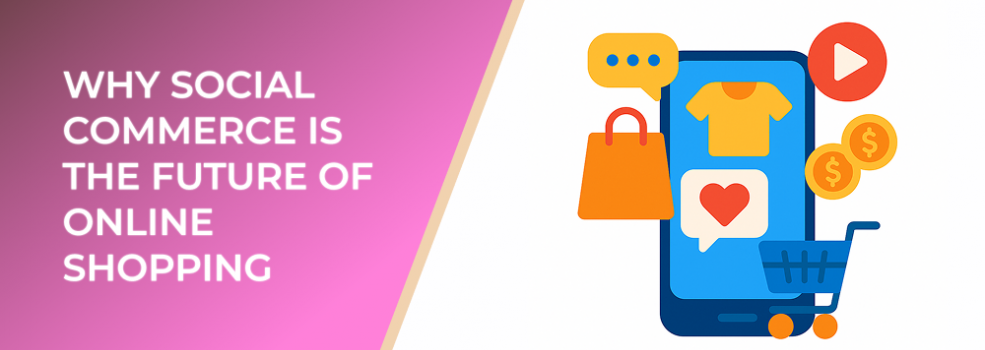Social commerce combines social media engagement with direct buying experiences. Instead of sending users to an external website, it allows them to browse and purchase products directly through platforms like Facebook, Instagram, and TikTok.

Projected growth of global social commerce sales from 2023 to 2025
According to Statista, global social commerce sales exceeded $728 billion in 2023 and are projected to reach $1.2 trillion by 2025. This growth highlights how shopping habits are shifting from traditional online stores to in-app experiences.
1. The Rise of In-Platform Shopping
Consumers want speed and convenience. Social platforms now offer native features that make purchasing seamless:
-
Facebook Shops: Businesses can create product catalogs directly on their Page.
-
Instagram Checkout: Users can buy without leaving the app.
-
TikTok Shop: Enables creators to tag products in videos for direct purchase.
Meta reports that 44% of online shoppers have bought something through social media, and that number continues to grow each year.
2. The Power of Social Proof
One reason social commerce is so effective is the influence of peer recommendations. Reviews, comments, and user-generated content act as real-time validation.

How much influence social media recommendations and mobile usage contribute to social commerce adoption
Research shows that 79% of consumers trust social media recommendations as much as personal referrals. This social trust makes users more likely to convert while browsing.
For brands, leveraging influencers, customer testimonials, and interactive content can build authenticity and drive sales.
3. The Role of Creators and Influencers
Influencers are at the heart of social commerce. Instead of traditional ads, brands now partner with creators who already have engaged audiences.
According to Sprout Social, 63% of consumers say they’re more likely to buy from a brand endorsed by a trusted influencer. This is why many e-commerce businesses invest in micro- and nano-influencers who drive niche audience conversions.
By using influencer collaborations with in-platform checkout, brands can reduce friction and create a smooth path from discovery to purchase.
4. AI and Personalization in Social Commerce
Artificial intelligence is accelerating the growth of social commerce by delivering personalized experiences. Algorithms analyze user behavior, preferences, and engagement to recommend products most likely to convert.
Meta and TikTok’s AI-driven recommendation engines are responsible for over 70% of engagement time on their platforms. These personalized experiences keep users browsing longer and make it easier for brands to reach the right audiences.
5. The Mobile-First Shopping Experience
Mobile shopping dominates the e-commerce landscape, and social commerce fits perfectly within that trend. Around 80% of social media users access platforms via mobile, making social commerce an intuitive part of their daily scrolling habits.
Features like one-click checkout, shoppable videos, and live shopping events have turned social apps into virtual malls—available in the palm of your hand.
6. Live Shopping and Interactive Experiences
Live shopping—a blend of entertainment and instant purchasing—is becoming one of the fastest-growing areas of social commerce. Viewers can interact with hosts, ask questions, and buy featured products in real time.
In China, live shopping already represents over 10% of all e-commerce sales, and similar trends are spreading globally. For Western brands, adopting this interactive approach early can help them stand out and build loyalty.
7. Social Commerce for Small Businesses
For small and medium-sized businesses, social commerce levels the playing field. Setting up a Facebook or Instagram Shop requires minimal resources compared to building a full-scale online store.
Businesses can also use analytics and engagement insights from social platforms to refine targeting and optimize campaigns.
Studies show that small businesses using social commerce grow 2x faster than those relying solely on standalone e-commerce sites.
Related Articles from LeadEnforce
-
How to Define a Target Audience for Marketing: A Step-by-Step Guide
-
How AI Tools Are Changing the Way E-Commerce Brands Run Facebook Ads
Final Thoughts
Social commerce isn’t a passing trend—it’s the future of online shopping. Platforms are turning into full-scale marketplaces powered by trust, influencers, and personalized algorithms. E-commerce brands that invest in these strategies now will be better positioned to capture attention, engagement, and long-term customer loyalty in the years ahead.

